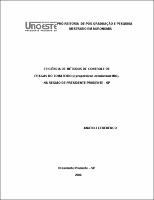| Compartilhamento |


|
Use este identificador para citar ou linkar para este item:
http://bdtd.unoeste.br:8080/jspui/handle/tede/570Registro completo de metadados
| Campo DC | Valor | Idioma |
|---|---|---|
| dc.creator | Lebedenco, Anatoli | - |
| dc.creator.Lattes | http://lattes.cnpq.br/1912336256556903 | por |
| dc.contributor.advisor1 | Auad, Alexander Machado | - |
| dc.contributor.advisor1Lattes | http://lattes.cnpq.br/5999622609037852 | por |
| dc.contributor.referee1 | Kronka, Sérgio do Nascimento | - |
| dc.contributor.referee1Lattes | http://lattes.cnpq.br/1179290055868311 | por |
| dc.contributor.referee2 | Barbosa, Leonardo Rodrigues | - |
| dc.contributor.referee2Lattes | http://lattes.cnpq.br/6144428502815666 | por |
| dc.date.accessioned | 2016-07-18T17:51:10Z | - |
| dc.date.available | 2007-03-19 | - |
| dc.date.issued | 2006-03-07 | - |
| dc.identifier.citation | LEBEDENCO, Anatoli. Efficiency of pest control methods in the culture of tomato (Lycopersicon esculentum Mill.) in the area of Presidente Prudente SP. 2006. 53 f. Dissertação (Mestrado em Ciências Agrárias) - Universidade do Oeste Paulista, Presidente Prudente, 2006. | por |
| dc.identifier.uri | http://bdtd.unoeste.br:8080/tede/handle/tede/570 | - |
| dc.description.resumo | Este trabalho teve o objetivo de avaliar cinco métodos de controle das pragas que infestam a cultura do tomateiro: a) Método convencional de aplicação de produtos fitossanitários, utilizado pelos agricultores; b) Manejo integrado de pragas (MIP) utilizando os níveis de controle (NC) de cada inseto-praga determinados pela pesquisa; c) MIP com o emprego de extrato de Azadirachta indica a 5% (Nim); d) Ensacamento das pencas de tomate logo após a floração e) Testemunha. O método convencional e o método MIP foram eficientes no controle das pragas do tomateiro, reduzindo o número de plantas viróticas e lepidópteros broqueadores, e em conseqüência, aumentando a produtividade da cultura em 156% e 165% respectivamente. O número de pulverizações foi reduzido em até 66,7% com o método MIP comparado ao convencional. O MIP-Nim apresentou baixo controle aos insetos sugadores e lepidópteros e não diferiu significativamente da testemunha. O ensacamento das pencas de tomate consistiu em uma alternativa promissora na produção de frutos sem a presença de inseticidas; no entanto, há a necessidade de proteção contra sugadores transmissores de vírus e utilização de material protetor de melhor eficiência | por |
| dc.description.abstract | This research aimed to evaluate five methods for the control of the pests that infest the culture of tomato: a) Conventional method for the application of phytosanitary products commonly, used by farmers; b) Integrated pest management method (IPM) using the control levels (CL) of each insect-pest determined by the research; c) IPM with the use of extract of Azadirachta indica at 5% (v/v) concentration of solution (Neem); d) Sacking the tomato bunches right after flowering. e) Control plants, without any treatment against pests. Both the conventional and IPM methods were both efficient in controlling the pests of the tomato and resulted in reduced number of viral infected plants, and as a consequence, increasing in productivity of the culture by 156% and 165%, respectively. The number of pulverizations was reduced in 66.7% with the IPM method compared to the conventional. The IPM-Neem method showed low control of the sucker insects and lepidopterous and did not differ significantly from the control. The practice of sacking the bunches of tomato fruits represents a promising alternative in the production of fruits without the employment of pesticides, however, it is necessary a protection against sucker insects transmitters of viral illnesses and demands the utilization of protecting materials with better efficiency. | eng |
| dc.description.provenance | Made available in DSpace on 2016-07-18T17:51:10Z (GMT). No. of bitstreams: 1 DISSERTACAO_AGRONOMIA_ AnatoliL_mar07.pdf: 471165 bytes, checksum: 5d2837d12d1418bc7070a2a9cc694841 (MD5) Previous issue date: 2006-03-07 | eng |
| dc.format | application/pdf | por |
| dc.thumbnail.url | http://bdtd.unoeste.br:8080/jspui/retrieve/1858/DISSERTACAO_AGRONOMIA_%20AnatoliL_mar07.pdf.jpg | * |
| dc.language | por | por |
| dc.publisher | Universidade do Oeste Paulista | por |
| dc.publisher.department | Ciências Agrárias | por |
| dc.publisher.country | BR | por |
| dc.publisher.initials | UNOESTE | por |
| dc.publisher.program | Mestrado em Agronomia | por |
| dc.rights | Acesso Aberto | por |
| dc.subject | Entomologia | por |
| dc.subject | Pragas agrícolas - Controle | por |
| dc.subject | Tomate | por |
| dc.subject | Tomato | eng |
| dc.subject | Agriculture pests - Control | eng |
| dc.subject | Neem | eng |
| dc.subject | Sacking of fruits | eng |
| dc.subject | Entomatology | eng |
| dc.subject.cnpq | CNPQ::CIENCIAS AGRARIAS::AGRONOMIA::FITOTECNIA | por |
| dc.title | Eficiência de métodos de controle de pragas do tomateiro (Lycopersicon esculentum Mill.), na região de Presidente Prudente - SP | por |
| dc.title.alternative | Efficiency of pest control methods in the culture of tomato (Lycopersicon esculentum Mill.) in the area of Presidente Prudente SP | eng |
| dc.type | Dissertação | por |
| Aparece nas coleções: | Mestrado em Agronomia | |
Arquivos associados a este item:
| Arquivo | Descrição | Tamanho | Formato | |
|---|---|---|---|---|
| DISSERTACAO_AGRONOMIA_ AnatoliL_mar07.pdf | 460,12 kB | Adobe PDF |  Baixar/Abrir Pré-Visualizar |
Os itens no repositório estão protegidos por copyright, com todos os direitos reservados, salvo quando é indicado o contrário.




